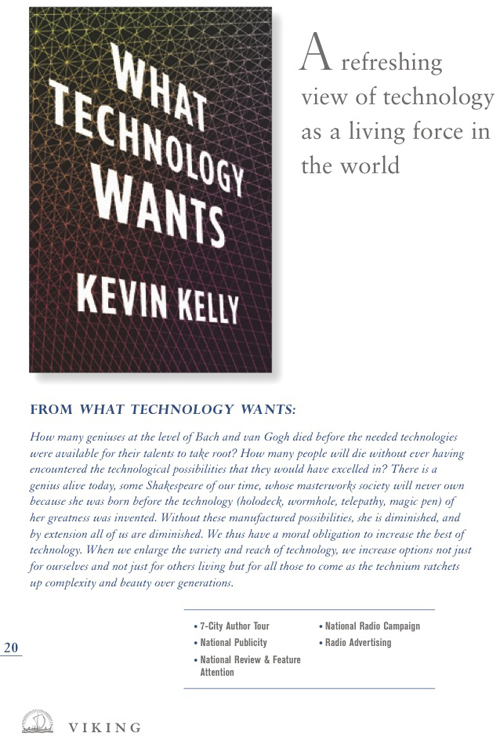
I've been following Kevin's work for several years, and am psyched in a extreme fanboyish manner to have pre-ordered a copy of What Technology Wants. It's out now so I invite urge you to purchase it here. Kevin's latest work is based on his blogging on The Technium of which I've read a good cross section of posts.
If you need a little convincing that the book is worth the purchase, I humbly submit for your review Evidence of a Global SuperOrganism and Extropy two of my absolutely favorite posts of Kevin's.
Teasers from the Super Organism:
I am not the first, nor the only one, to believe a superorganism is emerging from the cloak of wires, radio waves, and electronic nodes wrapping the surface of our planet. No one can dispute the scale or reality of this vast connectivity. What's uncertain is, what is it? Is this global web of computers, servers and trunk lines a mere mechanical circuit, a very large tool, or does it reach a threshold where something, well, different happens?
...
The majority of the content of the web is created within this one virtual computer. Links are programmed, clicks are chosen, files are moved and code is installed from the dispersed, extended cloud created by consumers and enterprise - the tons of smart phones, Macbooks, Blackberries, and workstations we work in front of. While the business of moving bits and storing their history all happens deep in the tombs of server farms, the cloud's interaction with the real world takes place in the extremely distributed field of laptop, hand-held and desktop devices. Unlike servers these outer devices have output screens, and eyes, skin, ears in the form of cameras, touch pads, and microphones. We might say the cloud is embodied primarily by these computer chips in parts only loosely joined to grid.
...
LEVEL II
An autonomous superorganismAutonomy is a problematic concept. There are many who believe that no non-living entity can truly be said to be autonomous. We have plenty of examples of partial autonomy in created things. Autonomous airplane drones: they steer themselves, but they don't repair themselves. We have self-repairing networks that don't reproduce themselves. We have self-reproducing computer viruses, but they don't have a metabolism. All these inventions require human help for at least aspect of their survival. To date we have not conjured up a fully human-free sustainable synthetic artifact of any type.
But autonomy too is a continuum. Partial autonomy is often all we need - or want. We'll be happy with miniature autonomous cleaning bots that requires our help, and approval, to reproduce. A global superorganism doesn't need to be fully human-free for us to sense its autonomy. We would acknowledge a degree of autonomy if an entity displayed any of these traits: self-repair, self-defense, self-maintenance (securing energy, disposing waste), self-control of goals, self-improvement. The common element in all these characteristics is of course the emergence of a self at the level of the superorganism.
Teaser's from Extropy:
Extropy is neither wave nor particle, nor pure energy. It is an immaterial force that is very much like information. Since extropy is defined as negative entropy — the reversal of disorder — it is, by definition, an increase in order. But what is order? Despite our intuitive sense, we lack a good operational definition of order, which seems to be tied up with complexity (see Ordained Becoming). For simple physical systems, the concepts of thermodynamics suffice, but for the real world of cucumbers, brains, books, and self-driving trucks, we don't have useful metrics for extropy. The best we can say is that extropy resembles, but is not equivalent to, information.
...
For four billion years evolution has been accumulating knowledge in its library of genes. You can learn a lot in four billion years. Every one of the 30 million or so unique species of life on the planet today is an unbroken informational thread that traces back to the very first cell. That thread (DNA) learns something new each generation, and adds that hard-won knowledge to its code. Geneticist Motoo Kimura estimates that the total genetic information accumulated since the Cambrian explosion 500 million years ago is 10 megabytes per genetic lineage. Now multiply the unique information held by every individual organism by all the organisms alive in the world today and you get an astronomically large treasure. Imagine the Noah's Ark that would be needed to carry the genetic payload of every organism on earth (seeds, eggs, spores, sperms). One study estimated the earth harbored 10^30 single-cell microbes. A typical microbe, like a yeast, produces one one-bit mutation per generation, which means one bit of unique information for every organism alive. Simply counting the microbes alone (about 50% of the biomass), the biosphere contains 10^30 bits, or 10^29 bytes, or 10,000 yottabyes of genetic information. That's a lot.
That Extropy post triggered one my personal favorite blog posts here, Why God's a Hacker where I struggle to identify the information capacity of life's coding blocks.
Please grab the book or at least read more of the Kevin Kelly's Technium. It's been a world view altering, mind opening experience for me and I can't wait to embrace it in book form.